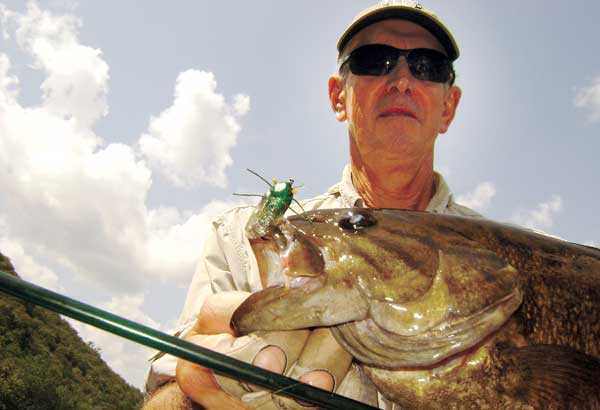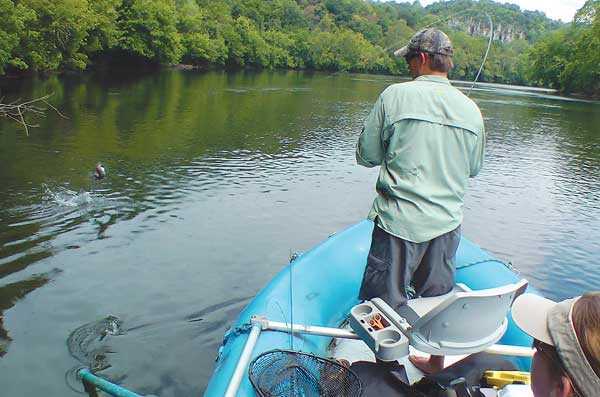By Britt Stoudenmire

The heat of the summer signifies the yearly emergence of the “dog day” cicadas. And for those of you that pursue smallmouth on the many streams and rivers in the Southeast, the cicada bite, also commonly known as the “bug bite,” offers the fly angler some of their best and most exciting opportunities of the year at trophy smallmouth.
While most anglers are familiar with the periodic cicadas that emerge in different areas on a 14 to 17 year cycle, the “dog day” cicadas are often overlooked. “Dog day” cicadas emerge every year around the month of July. With a short life cycle, they typically begin to die off after they lay their eggs during the months of August and September. As they die, big smallies move from the depths of the river to the shallows flats and banks in search of an easy meal. A cicada is like a brownie dessert to a smallmouth, and they simply will not pass one up if presented correctly. I start with a size-4 or size-6 cork bug. My favorite is a realistic pattern, my BKC bug, which mimics almost every feature of a cicada. I then tie the bug to a Froghair 2x (10’, 10lb, monofilament) tapered leader using a non-slip loop knot. I really like Royal Wulff’s triangle bass taper. It loads heavily on the front end and really turns over the big bugs nicely making a nice splat on the water. I strongly suggest a 7- or 8-wt fly rod for casting big bugs all day long, especially in the wind. But more importantly, the larger rod offers you more backbone after a big smallie sips your bug and heads directly for the sharp, limestone ledges that are found in so many of our southeastern rivers. Finally, the least important part of the set up is the reel. Often times, you never have the opportunity to go the reel when fighting a big smallmouth because they charge directly at you on the hookup, forcing you to strip in line as fast as possible. I favor very light reels and prefer Ross Reels’ Evolution LT #4 for its lightness.

The most important part of the equation is properly presenting to these fish. As you drift down the river, cast 45 degrees towards the bank with the front angler targeting very close to the bank and the back angler focusing on the first major drop in depth. The casting angle helps accomplish several things. First, it puts the fly out in front of the boat so that the fish does not sense your presence. Second, it helps you to dead drift your fly longer before it begins to drag. Are you thinking, “Did he just say “dead drift” the bug?” Yes, the single most important part of properly fishing a cicada bug is to dead drift the bug in light, fairly straight current until it drags. The number one way to spook a big smallie is to move the bug. If a big smallie rejects your bug, wait until he turns away, and make a quick mend. This technique will most likely cause the smallie to wheel around on the fly again, and if the drag is gone, you have a 50/50 shot that he will eat it.
Smack! Your fly hits the water and you see a big black glob coming towards a perfectly drag-free drifting bug. The huge smallie approaches very slowly, and right as the smallie begins to sip, you rip the fly right out of his mouth. You’ve just made the mistake that so many fly anglers have made before you. You must let the smallie eat that fly and then turn back toward to the depths. With that turn, you then strip tight and vertically pop that rod hard setting the hook back across the fish’s mouth and then begin to “strip, strip, strip…” as the smallie runs right at you. Once you get tight to the fish, most smallies will make one big, powerful run back to their safe havens. This is when the 8-wt comes in handy because you have to push the limits of your gear, lines, and knots. Once you slow-up the fish, your chances of landing him greatly increase. There is nothing better than chasing big smallies during “bug season” and the image of that big, black glob moving up on your bug will last forever.
Britt Stoudenmire and his wife Leigh own and operate New River and James River Outdoor Companies in Southwest Virginia just 2.5 hours north of Charlotte. Britt spends all of August and September on the New and James Rivers chasing big smallmouth on “bugs” out of his drift boat or fishing raft. Call him at 540-921-7438 or visit his website at http://www.newriveroutdoorco.com.
[easy-social-share]